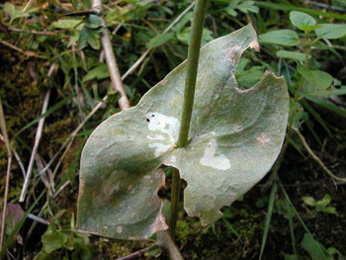|
||||||
| Chromatomyia
blackstoniae Spencer,
1990 [Diptera: Agromyzidae] |
||||||||||||||||||||||||||||||||||
|
Phytomyza
gentianae Hendel,
1920; Spencer, 1972. Handbk
ident. Br. Ins. 10 (5g):
95 [in part, misidentification] |
||||||||||||||||||||||||||||||||||
Leaf-miner: Larvae feeding in stem-leaves. particularly those immediately below the flower; mine initially linear, later developing into irregular blotch. Pupation internal (Spencer, 1990: 396). Initially a corridor, later an irregular blotch. Pupation within the mine; puparium whitish (Bladmineerders van Europa). The initial mine is a gallery, it later makes a lower surface blotch mine (British leafminers).
Larva: The larvae of flies are leg-less maggots without a head capsule (see examples). They never have thoracic or abdominal legs. They do not have chewing mouthparts, although they do have a characteristic cephalo-pharyngeal skeleton (see examples), usually visible internally through the body wall. Puparium: The puparia of flies are formed within the hardened last larval skin or puparium and as a result sheaths enclosing head appendages, wings and legs are not visible externally (see examples). Whitish (Spencer, 1990: 396). Comments: Spencer (1972b: 95) recorded Chromatomyia gentianae (as Phytomyza) on Blackstonia perfoliata and Centaurium erythrae (as minus). However, he later (Spencer, 1990: 396-7) recognised that specimens on Blackstonia perfoliata and specimens on Centaurium erythrae represented two different new species, which he described as Chromatomyia blackstoniae and Chromatomyia centaurii respectively. Hosts in Great Britain and Ireland:
Hosts elsewhere:
Time of year - mines: August (Spencer, 1990). Time of year - adults: Currently unknown. Distribution in Great Britain and Ireland: Gloucestershire (Kilcot) (Spencer, 1990: 396), Oxfordshire (Warburg Reserve) (British leafminers), Surrey (Boxill) (pers. observation). Buckinghamshire (NBN Atlas). Also recorded in the Republic of Ireland: Co. Clare (Murrough) (Spencer, 1990: 396). Distribution elsewhere: Northern France (Spencer, 1990: 396). NBN Atlas links to known host species:
British and Irish Parasitoids in Britain and elsewhere: Currently unknown. |
| Last updated 03-Sep-2017 Brian Pitkin | ||

